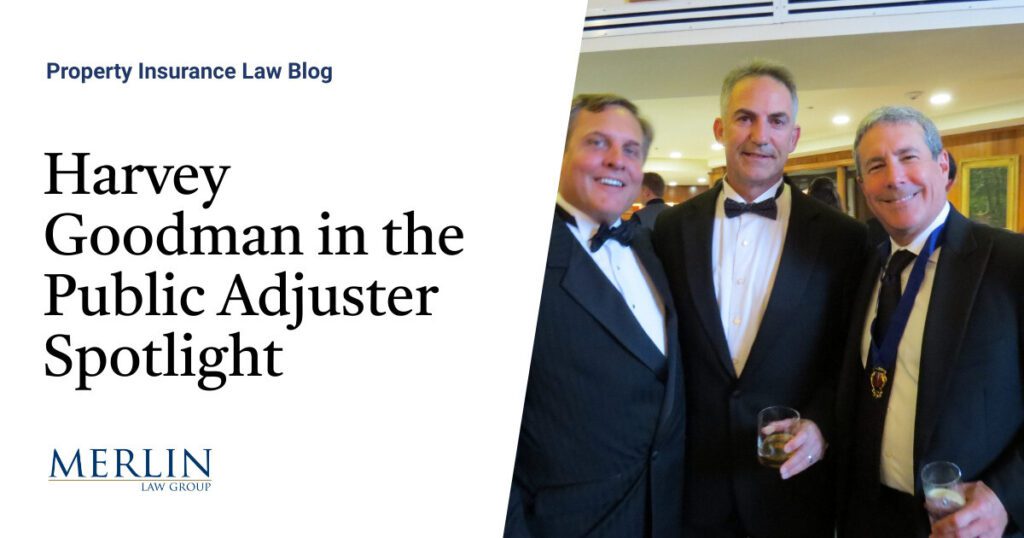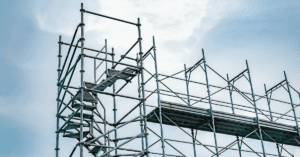Harvey Goodman in the Public Adjuster Spotlight

My first encounter with Harvey Goodman was at the National Association of Public Insurance Adjusters meeting in Carmel, California, in 1985. I was 26 years old and giving my first speech to a public adjuster organization after leaving property insurance defense. There is always one person in the crowd who loves to quiz the speaker—Harvey Goodman.
Since then, I have developed a deep respect for Harvey after working on a number of cases, discussing various insurance coverage issues and simply observing how he conducts himself and his business. When people ask me who the best public adjusters in the business are, he has been on my top five list for decades. It is hard for me to think of a property insurance issue where his study, knowledge, and actual experience simply is not at the highest depth of understanding.
Here is Harvey Goodman’s interview:
Who founded the company, and what role did it play in the founding of the National Association of Public Insurance Adjusters?
The company was formed in 1941 by a merger of the Goodman-Wagner company and Gable & Gould. The founding president and driving force of Goodman Gable Gould (GGG) was Will Goodman. Will Goodman was also a founder of the National Association of Public Insurance Adjusters (NAPIA) and its President for NAPIA’s first six years.
Paul Cordish was General Counsel to NAPIA from its founding in 1941 until approximately 2000. Cordish was the attorney who incorporated GGG in 1941. Paul Cordish and Will Goodman were best friends.
Is the Goodman who was the first President of NAPIA your grandfather?
Will Goodman was my father’s uncle. My grandfather was never in the public adjusting business. There hasn’t been a Gable in the business since before I was born, and there hasn’t been a Gould in the company for two generations.
Many people mistakenly think that I am a lineal descendant of NAPIA’s founder. However, my grandfather passed away when my father was eight years old. My father went to work in the firm after college, attended law school at night and was the president of NAPIA in 1986.
GGG has had seven past presidents of NAPIA. Among those include Karl Denison, who has been working at GGG for 42 years. My cousin Randy is also a past president and has been in the public adjusting business for over 50 years.
When did you first get involved in the business, and what did you do?
I started in the business while in college doing personal property inventories and have worked here full time (and sometimes more) for 47 years.
At one time, you planned to go to law school and that did not last—why not?
After college, I attended law school for only three days and decided it was not for me. I have been deposed and testified many times as a witness. I find it interesting how many lawyers have commented that I made the correct decision to stop when they find out I continued with public adjusting rather than a career in law.
My parents were disappointed, but I learned that seeking your own path leads to a more productive and satisfying career and life. The principle of finding your own path rather than somebody choosing it for you has helped me be a better parent, and every parent needs all the help they can get.
What has been your history with NAPIA conventions?
The first annual convention meeting that I attended was in Atlantic City when I was 13 years old. I remember that because I got bar mitzvah’d a couple of weeks later. To this day, I remember a couple of public adjusters who were close to my dad giving me bar mitzvah gifts at that convention.
I also went to a couple of other conventions in Florida when I was a teenager. There were some very “colorful” personalities in the industry at the time that made quite an impression on me as a young professional.
When I started working full time in the summer of 1977, I began regularly attending conventions and was elected to the NAPIA Board of Directors in 1981. I served continuously until I was put on the ladder and was installed as president in 1998 at Landsdowne Resort in Leesburg, Virginia.
Tell me what it was like to work with Paul Cordish?
I was one of the last presidents to work full time with Paul Cordish. I knew Paul well as he was also GGG’s general counsel. He was one of if not the smartest people I ever knew. He forgot more about public adjusting than most people ever knew. He was encyclopedic in his knowledge of insurance, and he had previously been a member of the Maryland State Legislature.
Randy Goodman, who followed me as president of NAPIA, and I were also instrumental in having Paul Cordish agree to bring on Brian Goodman to learn from him and eventually take Paul’s place as NAPIA’s general counsel. At the time, Paul was about 90 years old and it seemed like a transition was needed. Paul Cordish and Brian Goodman have been the only two general counsels that NAPIA has ever had.
What are the most significant technological and industry changes in public adjusting since you first started?
The technological changes in the industry have been a natural occurrence as technology is changing everything in our lives. Sometimes that is good, and sometimes it is not. It can actually be both at the same time.
I remember when I started, we hand wrote our inventories using carbon paper to make multiple copies for the insured, the insurance company and for us. We then would go back to the office, price the inventory and use an adding machine to total the numbers. We would print the adding machine tape and check it against the inventory.
Those repetitive processes are completed more easily with technology and software that does many of these tasks for you. However, what is lost is I would intimately know the inventory and could discuss it and advocate for our client, the insured.
Today, the people at the insurance company are looking at photos and reading analytical reports, but often have never been to the loss location. For them, it is just a numbers game. The old-time field adjusters are retiring, and the training the new adjusters get is not always in the field. People need to be mentored to understand the process and make it work, no matter which side of the table you sit on.
How has your organization changed in the last 20 years, and what is your most significant management challenge?
The biggest management challenge in any organization is people. We’ve had a great track record for keeping people, but it’s always a challenge. As you know, we have many people in our organization who we hired out of college. Many of these have made our firm their one career choice and have been on our team for decades.
We have turned management of the firm over to six principals who range from mid-thirties to early fifties. Our senior people are still involved in the adjustment process; however, we needed more youth and fresh ideas. I am very proud of these younger professionals who have been with our firm for years and are more than ready to step into management roles.
What is it like to have your family working with you?
I have the great benefit of working with my daughter, who joined GGG after a successful career in New York real estate, and my son-in-law (married to a different daughter), who joined GGG out of college. I could not be more excited to come to work every day and interact with them, albeit in many ways, they have already surpassed whatever I may have accomplished in my career.
How has your firm changed over the years?
Will Goodman wrote an article for Best’s Guide in 1951 that seems as if it could have been written today. My belief and understanding was that NAPIA was formed to raise the professionalism of the industry. When I started in the business, many states like Maryland, Pennsylvania, Ohio, and Florida had residency requirements for licensure in a state. Our firm and NAPIA were instrumental in repealing the residency requirements, which were more restrictive than helpful to the consumer as well as the public adjusting industry.
This is one reason for our firm’s evolution regarding the types of claims we handle today versus the claims being handled when I started. We were a local firm in 1977, with two offices in Maryland. We occasionally went out of town for our clients who called us. We had strong pockets of business in Southern Virginia, West Virginia, Pennsylvania, and Georgia. In the 1980’s, we expanded further into those areas and the Carolinas. In the 1990s, we expanded into Florida and north to New York, New Jersey and Massachusetts.
We currently have offices in eleven cities, and we have active claims working in dozens of states, including Hawaii and Alaska. A significant part of our business comes from referrals from prior clients and contacts in the business community.
What has NAPIA meant to you personally and professionally?
NAPIA has been great for me personally. I have made some of my closest friends there.
I have also learned from many deeply experienced public adjusters. I loved sitting at the bar listening to and learning from Sidney Greenspan, Bruce Swerling, and Bob Lucurell, among others. After my father, they were some of the brightest minds in the business.
It has also been great interacting with the stars of the business from my generation, such as Ron Papa, Bill Greenspan, Jim Beneke, Bobby Levin and others who grew up with me in the business. We have common issues with claims and common issues running a business.
I even got to spend some quality time running with you at a few conventions while we were training for half marathons and marathons.
How would you describe your philosophy of property insurance adjustment, why have you become so successful at it, and what would you suggest to a younger public adjuster?
At GGG we’ve always nurtured a great work culture. Two very important things I’ve learned and tried to pass on to the next generation are hard work and great communication. We put in the hours needed to get the job done, and we are very proactive with both our clients and the insurance company.
We train our people that you don’t wait for the client or insurer to call you. We call our clients to keep them informed as to what is going on and even let them know when nothing is going on. In the claims process, that is not always the easiest action because the process often seems more difficult in the middle of the claim. However, with hard work and due diligence, these matters do get resolved.
In life, business and claims, things will not always go smoothly. It is how you respond and react when things don’t go as hoped or planned that shows who you are. I’ve learned that my partners and the team at GGG are the people I want to be in the bunker next to me when bullets start flying.
Once, while working on a very large loss, Harvey and I left his busy office for dinner. When we came back after 8 pm, everyone was still there working. I was amazed and asked if it was always this way at his firm. He told me, ‘Chip, people always ask how we get such large claims like the one we are working on tonight. I don’t think others realize how hard all of us work here. I did not tell them to stay. For all I knew, they probably assumed we would be gone for the evening. It is our people and our work ethic that I think makes the biggest difference.’
If you are passionate about and love what you do, as Harvey Goodman does with public adjusting, is it really work or just high-level play?
Thought For The Day
The master in the art of living makes little distinction between his work and his play, his labor and his leisure, his mind and his body, his information and his recreation, his love and his religion. He hardly knows which is which. He simply pursues his vision of excellence at whatever he does, leaving others to decide whether he is working or playing. To him he’s always doing both.
—James A. Michener




